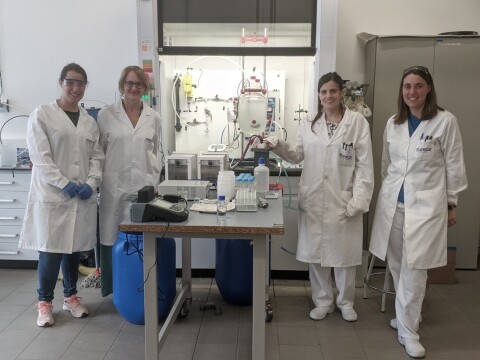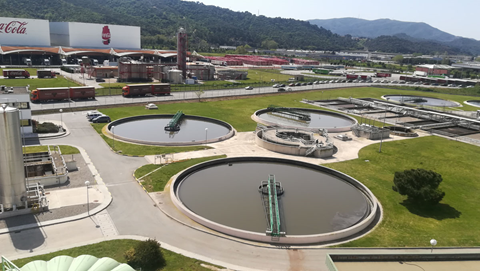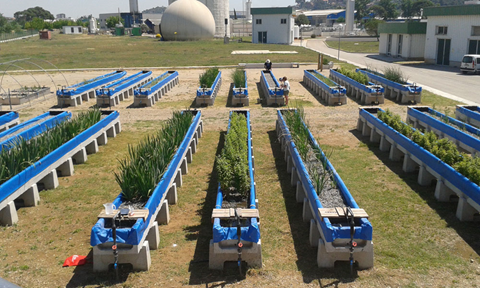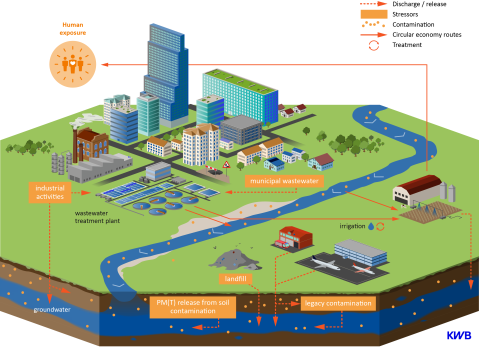CS #3: Water reuse from a wastewater treatment plant with a high share of industrial wastewater, Barcelona Province
Partners: EURECAT, CBT, IDAEA-CSIC
Our Aim: Obtain water for irrigation from industrial wastewater
Montornès del Vallès Wastewater Treatment Plant (WWTP) has a high proportion of industrial wastewater, which accounts for approximately 60% of the incoming flow. This wastewater comes from sectors such as pharmaceuticals, organic chemicals, food processing, metal finishing, leather, and textiles. This significant industrial contribution plays a key role in the presence of persistent and mobile toxic compounds (iPM(T)s) and PFAS in the discharged water, making it a critical focus for tackling contamination and improving water treatment processes.
In response, the PROMISCES project, driven by a consortium including Eurecat, Consorci Besòs Tordera (CBT) and IDAEA-CSIC, aims to develop innovative treatment strategies for water reuse in regions such as Catalonia, where drought and water scarcity remain pressing issues.
The technological strategy for water reuse involves a hybrid treatment combining e-Peroxone (ozonation and electrochemical oxidation, EAOPs) followed by a nature-based post-treatment (constructed wetlands, CWs). Using plant species such as Phragmites australis and Iris pseudacorus, CWs serve as a post-treatment stage, enhancing effluent quality and providing additional environmental benefits, including promoting biodiversity.
Conclusion
A non-target screening approach was used to identify iPM(T)s, with industrial application-related compounds being the second most prevalent among detected contaminants. Compounds were prioritized based on toxicity, mobility, concentration, and identification confidence. Initially, 25 key substances were selected for targeted analysis, later expanded to around 40 using IDAEA-CSIC's expertise and past research. For PFAS, a targeted analysis method was specifically applied.
Find here more information about the development of suspect screening workflows for PFAS and other iPM(T)s.
At the laboratory scale, the oxidation technology effectively removed PFAS (three compounds) and iPM(T)s (nine substances). Although the e-Peroxone process (30 A, 384 mg O₃/L) outperformed electro-oxidation, PFAS removal required nearly ten times more energy than iPM(T)s, highlighting their persistence.
At the Montornès WWTP pilot, the integrated system achieved high iPM(T) removal rates, improving effluent quality to meet EU and national standards. Most iPM(T)s were removed within 180 minutes, with the wetland complementing the e-Peroxone process by treating resistant compounds. PFAS removal showed no consistent trend; however, an overall 90% reduction in PFAS activity was achieved, according to CALUX assay.
The PROMISCES project studied the reuse of treated secondary WWTP water for irrigating lettuce (Lactuca sativa), focusing on the uptake of iPM(T)s and PFAS. Lettuce was irrigated with reclaimed water, secondary effluent, and bottled water (controls). The study evaluated crop productivity, quality, metabolomic changes, and potential consumer health risks.
After 41 days of cultivation, only trace amounts of PFAS were detected in lettuce, with industrial chemical concentrations remaining consistent across all irrigation treatments. Lettuce irrigated with wastewater exhibited elevated lipid and chlorophyll levels, suggesting a stress response. Although PFAS levels in lettuce grown with wastewater exceeded the tolerable weekly intake, the use of reclaimed water helped mitigate consumer health risks.
Based on these results, this hybrid treatment tackles the water scarcity in Mediterranean regions, making reclaimed water a sustainable and practical option for agricultural irrigation. Ongoing research and investment are crucial for advancing circular water economies.
Find here the complete description of this case study.





